

Version 1.2 last revised on 02/08/2001. Any comments or suggestions please direct them to Vorlon001
This Unlooper Guide is maintained and
hosted by The DSS Underground. Linking to this guide is ok, however
anyone interested in hosting this guide must first contact Deejay for approval.
We offer this unlooper guide in zip file format for download in the DSS Underground member's files section. If you are premium member you can download it from there. But if you are not a premium member you can still download this guide by just going to the file menu and select save. Save this as a webpage and the picture subdirectory will be saved as well! Since the guides were written in Microsoft Word2000 and some people have difficulty with it, this guide is written in HTML and can be read from a browser. It uses no frames and only a few .gif and .jpg files to supply the images used. All links keep all files in the same directory and this will run from whatever directory you create to unzip this file to.
Also there is a DSSU Programming Guide
available so check it out: Programming Guide
PLEASE
READ, VERY IMPORTANT:
The use, possession or importation of
Test (Programmed/Pirate) Cards is Illegal in the United States.
If you are a U.S. resident, you are required by law to subscribe
and use of Test Cards of any kind is unlawful and subject to
Criminal and Civil penalties according to U.S. law. We do not
condone use of Test Cards to U.S. residents. You and you alone
are SOLELY responsible for abiding by the laws of your Country,
State, Province or Territory. THE DSS UNDERGROUND WILL NOT BE
HELD RESPONSIBLE FOR THE ACTIONS OF THE PEOPLE USING THIS
DOCUMENT. This Unlooper Guide is strictly for EDUCATIONAL
USE ONLY. Also the DSS Underground also does not
and will not take any responsibility for what might happen to any
card using the following procedures. In other words, USE THIS UNLOOPER GUIDE AT YOUR OWN
RISK.
So with that out of the way let us say
that what we are trying to offer here is a basic and simple
instruction that hopefully will make everything as easy for you
as possible. We also want these instructions as safe as
possible, meaning we want to try our best to avoid having your
card become damaged. But remember nothing is absolutely foolproof
and don’t let anybody ever tell you differently. There is
always a risk taken whenever you attempt to clean an H card. But
also at the same time if you follow certain precautions you can
lower those risks and that is what we have tried to do with this
guide. But sometimes people, when they run into an error or when
they get confused about what they are doing, will guess or
attempt to try things on their own resulting in creating possibly
a more serious problem. If during any of the following
instructions you should get any kind of error message or if you
become confused and don’t understand something stop
immediately, make note of any on screen message(s) and then
go to the DSS Underground
Unlooper Forum and seek
out advice. Usually there is always somebody online that will be
more than glad to help you out. If you do need to seek out help
again please be specific when posting your problem and also give
as much detail as possible. Also it is strongly recommended that
you thoroughly read through this whole guide before you actually
attempt to do any of the offered instructions. Also just to point
out, this guide is geared to The WildThing II (WT2) unlooper
technology, which also includes WT2 clones.
Advice and Recommendations
Before we go on any further lets cover a
few things. First off even though the pricing for unloopers has
recently dramatically been reduced unloopers are still not for
everyone. If you have never programmed an H card using an ISO7816
Compatible Programmer then I strongly suggest that you stop right
now and rethink this a bit longer. First off you cannot program a
card with an unlooper. Recently, dual programmer/unlooper units
have become available. Any reference to programmer, assumes one
of these units in the programmer mode! DSS software
programs like WinExplorer and BasicH cannot be used with an
unlooper. You cannot install stealth scripts like
SummitStealthPro or DssStealthPro with an unlooper. These
programs and programming scripts require a programmer. An
unlooper actually serves only two primary functions. It is used
to unloop (also known as fixing) or clean H cards by returning
the EPROM Image of the card nearly back to a virgin state. Second
it can be configured using specific unlooper software to write
Images (not to be confused with bin files) to H cards. Now in the
hands of the right person the unlooper can do these tasks very
fast and very efficiently. But again in the hands of the wrong
person it can just as quickly and efficiently turn that H card
into an ice scraper. So we strongly suggest that really think
long and hard before deciding if an unlooper is for you.
What To Expect Or Better Yet, What
Not To
Expect Out Of This Guide
While it is impossible to give every instance of errors in the DOS programs, we will try to give a fully functional explanation of the workings of these, the first of the Unlooper Programs. Since these are used less than the present Windows Programs, a little DOS savy is required to use them to full advantage. We will cover the SU2v2.exe program, Prog.exe, M, M2 and mention T5-ATR.exe as well.
Atmel Chips involved:
WTI Atmel Chip.....Originally used with Prog.exe, M, and M2. After the 10/9/99 Magic ECM, this chip was rendered useless for the damaged cards. The next chip was developed.
WTII Atmel Chip....This is currently the most commonly used chip in most of the standard unloopers available. It's code is used in all versions of the newer chips.
SU2 Atmel Chip.... The Super Unlooper chip from Studluv69. It is the same code as the WTII but is coded to also accept the use of the SU2 software. This is DOS based like Prog.exe but has the Magic ECM repair ability, as well as other glitch points. It is now necessary to unloop an image cards that were hit by the 01/21/01 ECM. A special section has been added to this guide, just to cover this situation!
Unloopers:
At this point, let me say that all unloopers are the same, electrically! Whether they use an Atmel and discreet chips or an Atmel and an AVR to replace the discreet chips, THEY ARE FUNCTIONALLY THE SAME!
The Main difference in unlooper function is due to the software employed, not the unlooper! Since this guide covers the DOS software, a little explanation is in order. This software often works when no other software will because, at the DOS level, it has better control over the Serial Port Communication than some of the Windows software! I/O calls are made directly to the port, allowing better program control.
What you will Need..........
You will need to download the required DOS programs. The Members Files area has a complete package that contains everything you will need to start.
REQUIRED PROGRAMS:
Prog.exe Bin2img.exe
M.exe B2clone.exe
M2.exe Imgchk.exe
T5-ATR.exe
SU2v2.exe (requires the SU2 chip to operate)
For the DOS impared, you will find Wbin2img and ULEdit useful as well. Available in the Members Files Section of the DSSUG, and at other download sites.
Procedures for prog.exe with an unlooper to fix, clean, and program a card. While it can be run from a DOS Window on some computers, it is recommended that you run it from Pure Dos! The program also requires that all of your required images (Fixbin.img, Clone.img, and Virgin.img) , be located in the same directory as Prog.exe! Also, Imgchk.exe, if present, will check images when they come up.
We recommend using PURE DOS, obtained by pressing F8 when
booting the computer or when booting from a boot diskette.
COM1FIFO=1
Autoselect=off
This will shut off the RS232 buffering. You can also do this in your computers Setup Mode under Serial ports settings. Earlier Machines do not have the above problem and many successful professionals use 486 Dos machines to run their Dos based software!
Go to the directory with the prog.exe program in it. Connect your unlooper and apply power to the unit. Do NOT insert a card at this point. If you get an error such as can't find unlooper, then you have a CPU speed problem or you have a port conflict. Also make sure you are using a straight through RS232 cable and not a null modem cable. Prog.exe stores it's image files in the same directory the program resides.
Double click on
the Prog.exe program or in pure DOS, at the prompt, type Prog and
when you are up and running, you screen should look like this if
you are in a dos window:
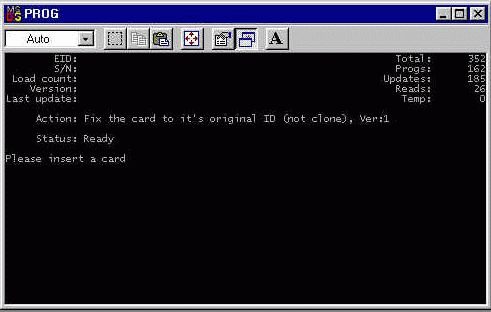
The screen should look like below if you are running in pure DOS:
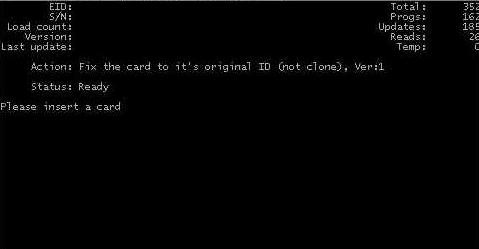
Unlooper Action is selected by using the "-" (minus key). You can select from Read Card (pressing "R") , or any images that you have in the same directory. Normally, you would use Fixbin.img to repair a card to it's original ID. This is possible in most cases and will just clean the card. If there is a problem with the card and there is corruption of the ID or ZKT tables or Keys, you may have to load a clone.img to apply to the card to correct the problem. In the above screens fixbin.img is loaded and ready to fix the card.
When you have inserted the card, the program will start and the screen will look like the picture below:
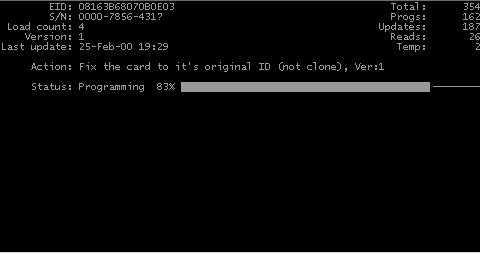
When completed, the program will tell you that it's complete and request that you please remove the card. The card is restored to near virgin state with it's original ID intact.
If you are just trying to program a card for testing purposes, or you decide to clone a card, do the following: Hit either the "+" or "-" keys and it will cycle through the available images in your unlooper directory and display your options. Once you have the correct image displayed, you simply insert your H card and it will attempt to perform the desired action. The program will tell you if there is a problem with the card and it cannot be programmed.
If you just wish to read a card, with no card in the unlooper, just press "R" and Prog.exe will toggle to the read function. Insert the card, and it will read, creating a file called Image.dat in the current directory. Win2.img.exe in windows will convert the .dat file to a usable card image with an .img extension. (Intel Hex File).
In the DOS package, there are 2 other programs, bin2img.exe and B2clone.exe. These perform the above image making function from pure dos and make either a complete image or a clone image of the card.
The SU2v2 Program and it's relation to Prog.exe:
From this point on, we will use some SU2 screens in the explanations. All of the functions but two are normal. The SU2 software uses setup2 just like WT 3.0 Windows software and it also has a setup3 or random glitching mode that prog.exe does not have. The screen's will look very familiar. SU2v2 will run nicely from a DOS Window on most computers without fancy I/O cards.
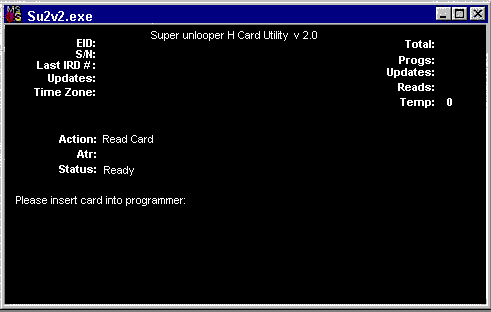
After you insert the card, the reading....message will come up on the screen:
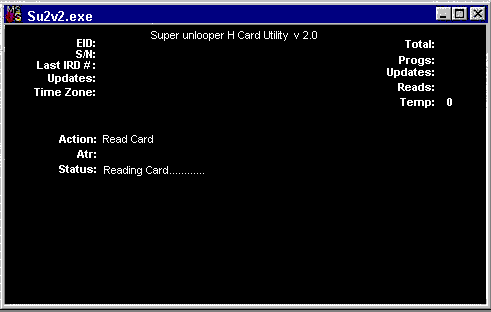
The above screen shows you have powered up the unlooper, loaded su2v2.exe and are ready to read a card since you pressed the "R" key. The rest works like prog.exe. You insert the card and it will read. In the picture below, you have used the "+" or "-" key to select fixbin.img and will repair a card when it is inserted.
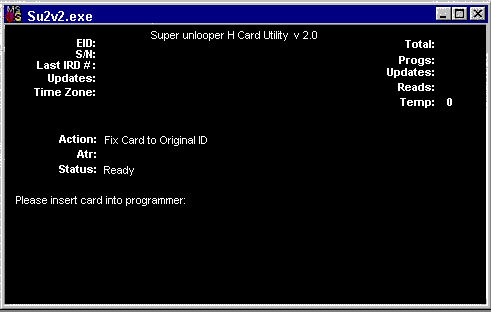
Ah Yes, the problems:
The screen below shows a problem that does not happen too often, the presence of a bootloader on the card. This can be caused by two things. One, a programmer placed it there to protect the card from being read. Two, a card was removed too soon from an unlooper. (When an unlooper writes to a card, it first loads a bootloader on the card. It then writes to the card, using it. After the write, the loader is removed and the data is returned to normal in the bootloader section of the card. Cards exhibiting this error, are best read using Dexter's BasicU.04. It will use a clean bootloader, if present to read the card!
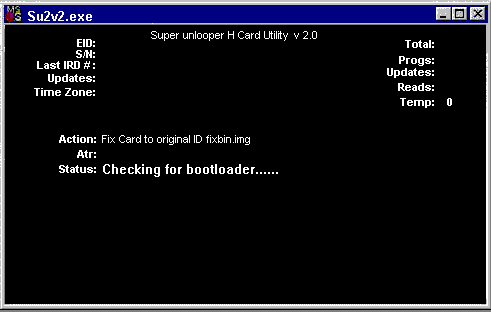
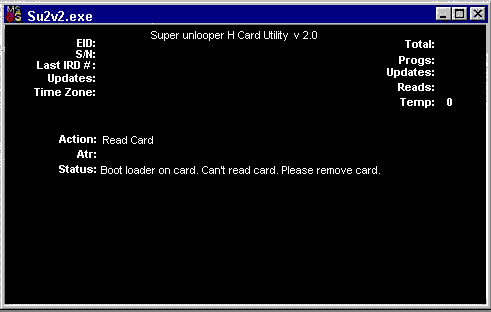
If any of the above error messages are noted, it is best to retire to BasicU to try to get at the card.
Of course, you could be trying to read or program a card as below. All seems to be going well........

Then you get the screen below. It will be almost the same in Prog.exe as well.
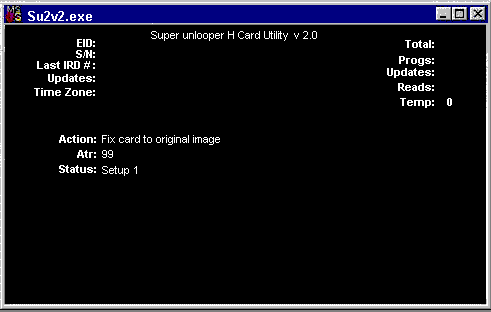
This indicates that the card is looped! In the above case, an ATR of 99. The unlooper program has gone into setup1 to try to fix the card. If you are using prog.exe and it is unsuccessful, it will exit at this point. The SU2 software, like WT 3.0, will go into setup2 mode below:
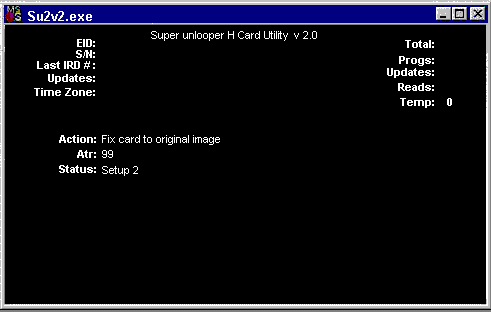
The setup2 mode will run and if it does not have any success, it will give an error message of Can't read card. It will ask you if you wish to continue with the Random Glitching mode. In most cases, this is not advisable and you should remove the card and try again by answering "NO" to the random glitching.
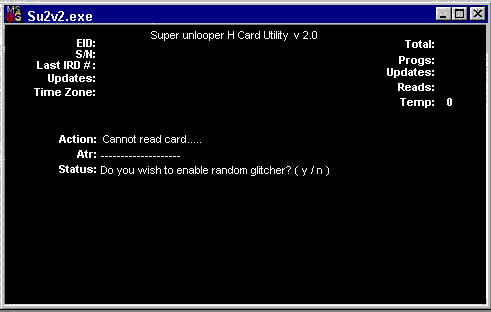
At this point, if you answer "N" then the program will exit. Just run it several times with either fixbin.img or clone.img and hope the software will get in.
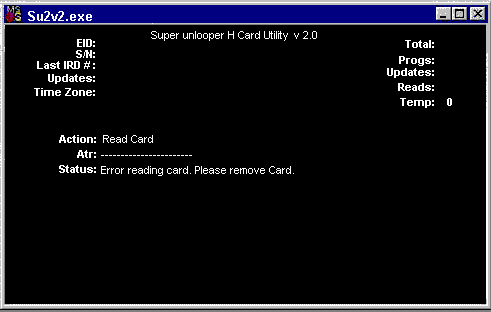
Of course, if the card is stubborn, you will enter the random glitching mode and the screen will appear as below. Random glitching will commence and you will be updated in the ATR and on screen as to what is happening.
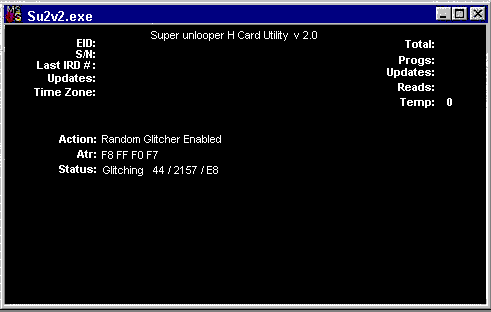
While I did a few pictures to make this a little easier to follow, there are a few other hints that can help you. First, the SU2 software does not come with a speedup file. It will, however, use one if present so a good file, like the one that comes in the DOS package in the Member's Files Section will help. It had nearly 2000 cards run through it. This is the Tune.sts file. It should also always be in your Prog.exe directory as well.
Bloody Sunday ECM and the Su2 Software update:
With the ECM of January 21, 2001- Your Su2 software will go into the setup3 mode and within no time will read the card. You can save the image and look at it with ULEdit. You can then see what was written to the cards. You can also write to the cards by using images but you will not be able to repair the damaged bootload area. The card will function in a bootblocker board, however. Many of these will be hitting the market shortly! Until Triton patches the Wildthing software, it is suggested you brush up on your image making! Also, the wtbsboot01p.zip file contains code that will allow your unlooper to work as a blocker board for emulation and will allow AUXing your card. Read the instructions contained in the zip file for that program. While I support unlooper guides, Emulation is not my best area of expertise and I recommend you to the DSS Underground Unlooper Forum as well as the Emulator Forum and Black Sunday Workaround forums to assist you further!
Using SU2 software is alot like using WT 3.0 Windows software. They are very similar in function. You will often find that when no other Windows software will fix a card, that the DOS programs will!
1. Either click on a shortcut to Su2v2.exe or from a DOS prompt, type su2v2 and the program will come up.

2. Insert the Bloody Sunday ECM card into the Unlooper. The program will jump from Setup1, quickly to Setup2 and the action will show glitching going onl.
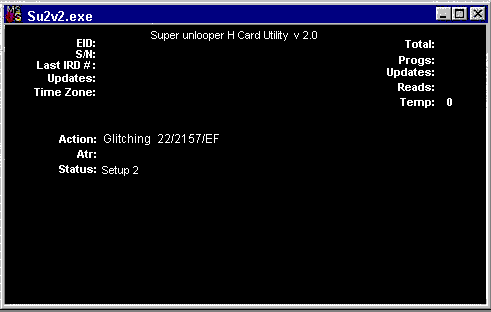
3. The program will go into the Setup3 mode. This may or may not be indicated on the screen, depending on how the program arrived to this state. It will have detected a trashed bootload area.
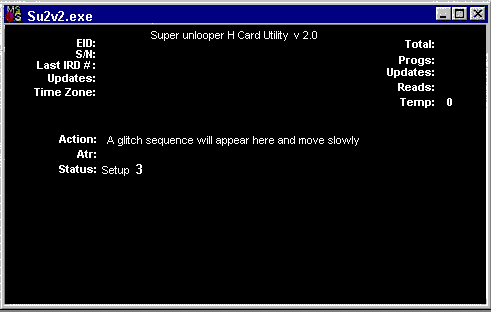
4. If all goes well, an ATR will appear on the ATR line. Glitching will go into a slow glitching mode with the glitches targeting the bootload area of the card.
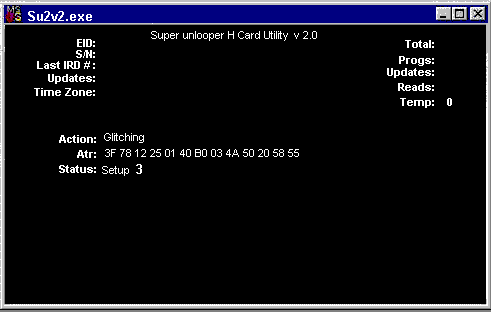
5. All of a sudden, the glitching sequence will vanish and the status bar will show the card image being read by the program.
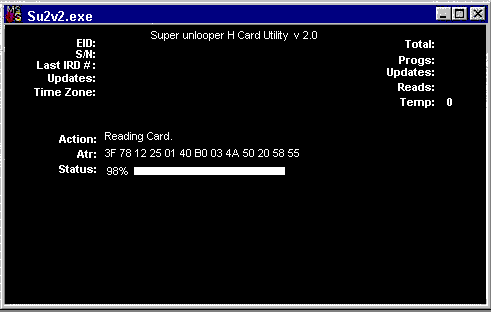
6. If the image you read is already on file, you will receive a message on the screen similar to what is below. If you answer (Y), the image will be replaced. If this was a pre-ECM image, it is recommended you do not replace it. Hit (N). You will then be prompted if you want to save the image. If you respond (Y), it will ask you to give a name to the image to be saved. Name and save it.
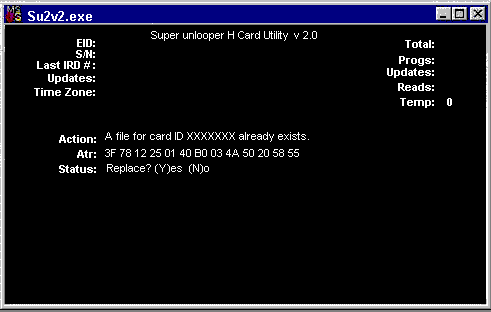
6. Rename the image to something recognizable and save it. It will be saved in the Himages subdirectory that Su2v2.exe resides.
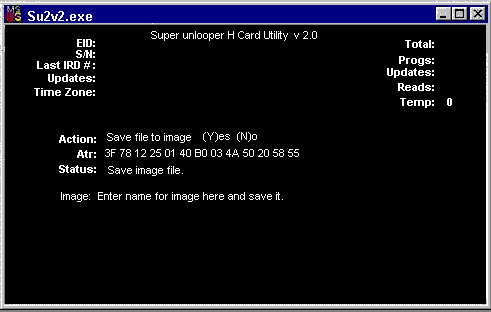
7. Su2v2.exe can be used to clean a damaged card as well. You can use fixbin (selected by using the "+" or "-" keys to scroll through. This will repair the card back to USW 26 like any normal fixbin.img. You can also take a clean, original bin of your card and open it in BasicH 3.2. For present conditions, clean the image in memory to 63 updates. Use the imagetool feature of the program and save the resultant image file as say....Myclone Image. Move this image to the SU2/Himages and you will be able to scroll to it. Once selected, insert the card and the image will be programmed to the card. Note that the glitching sequence will occur before the write happens as the card immediately reloops when inserted into the unlooper and an ATR (answer to reset) is sent to the card. The program will remember the problem with the card, glitch in, and write the clean image to the card.
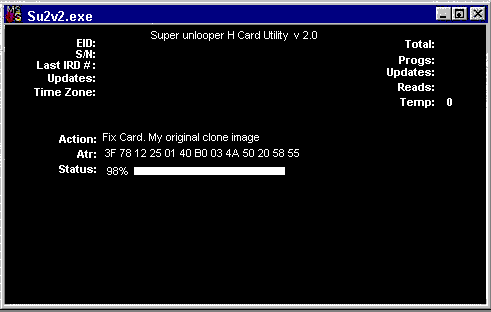
While the above Su2 section is not meant to be a complete guide to the Su2 software, it is about the best available that I have seen as little documentation was ever released for this program. Often, the Action line and Status line change several times during a process and I am not about to draw up all possible error codes or messages the program will respond with. Any complaints about the Su2 software and lack of documentation can be addressed to Studluv69 and not me. I am just trying to do my part to make the program easier for you to use. I know that DOS is not your thing but with the current ECM problems, it is a necessity for both Unlooping and Emulation!
The EQ[ II ] Software:
I will not cover it in detail here, as it is very similar to the SU2 software. It was used by Northsat and was based on the original WT dos software with additions like SU2. It works very well as do all of the DOS based products. Currently has little or no support available.
The M.exe, M2.exe, and T5-ATR Programs....
You have often seen references to these programs as the programs of last resort. This is very true. First off, don't bother with T5-ATR as it does essentially nothing! The other two, however, can be considered as similar to WT6 Ultraglitch with no boundaries! They were written as a pseudo fix to make the WT I atmel chip attempt to unloop Magic ECM cards. It did get a couple fixed and thus remained in the unlooping arsenal.
Both M.exe and M2.exe require that the card be inserted into the unlooper before the programs are started. They should only be run in Pure Dos! When they start, they attempt to pulse the card and if they get a response, they attempt to lay down enough info on the card to get an ATR. This has occasionally worked. If an ATR is gotten, you should exit the program, bring up prog.exe or su2v2.exe, and hope for the best. Both of the above programs are for really bad, no ATR cards.
Do not allow the above programs to run for any great length of time. A few hours is, at best, too much. You should get results in less than an hour or stop, wait, and try again.
The Image Makers.........
I will not go into detail on the DOS image makers as most of you use the Windows versions of the software. The DOS versions of the unlooper programs save a file as image.dat. Using the image maker for either making a full clone or regular image, you supply the name and an .img file is saved. They are very stable and work very well.
Also note that the Su2 programs (Su2.exe and Su2v2.exe) are DOS but save the images in true .img format. Imagetool (available seperately or in BasicH 3.2) can also make an image from a .bin file. An image can be used by BasicH 3.2 to patch a current .bin file in the program memory. The same holds true for BasicU.06 by Dexter. The images can easily be directly edited using the program ULEdit.exe available here and other download sites.
This
guide, with the exception of the intro and warnings, was written
by Vorlon001. It was done specifically for the DSSUNDERGROUND and
may not be downloaded to or hosted from any other site without
the expressed permission of Deejay , the owner of DSSUG. I ask that
you respect this request as maintaining these guides is a lot of work and is
presently copyright 2001 by me, Vorlon001.
This page copied from the VorlonHomeworld!
This
site Copyright 2001 by Vorlon001 all rights reserved.